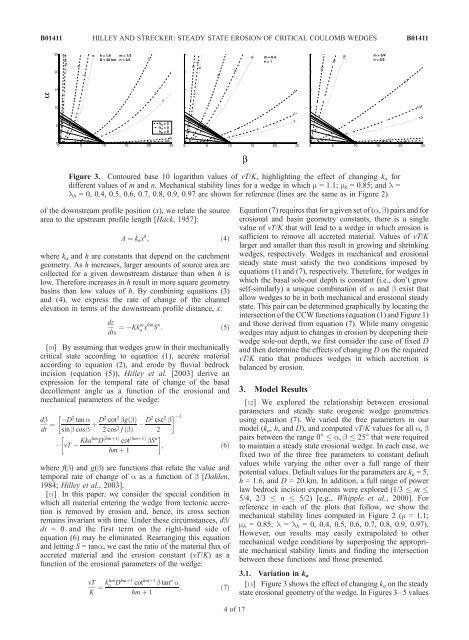Steady state erosion of critical Coulomb wedges with applications to ...
Steady state erosion of critical Coulomb wedges with applications to ...
Steady state erosion of critical Coulomb wedges with applications to ...
You also want an ePaper? Increase the reach of your titles
YUMPU automatically turns print PDFs into web optimized ePapers that Google loves.
B01411 HILLEY AND STRECKER: STEADY STATE EROSION OF CRITICAL COULOMB WEDGES<br />
<strong>of</strong> the downstream pr<strong>of</strong>ile position (x), we relate the source<br />
area <strong>to</strong> the upstream pr<strong>of</strong>ile length [Hack, 1957]:<br />
A ¼ kax h ; ð4Þ<br />
where ka and h are constants that depend on the catchment<br />
geometry. As h increases, larger amounts <strong>of</strong> source area are<br />
collected for a given downstream distance than when h is<br />
low. Therefore increases in h result in more square geometry<br />
basins than low values <strong>of</strong> h. By combining equations (3)<br />
and (4), we express the rate <strong>of</strong> change <strong>of</strong> the channel<br />
elevation in terms <strong>of</strong> the downstream pr<strong>of</strong>ile distance, x:<br />
dz<br />
¼ Kk<br />
dtb<br />
m a xhmS n : ð5Þ<br />
[10] By assuming that <strong>wedges</strong> grow in their mechanically<br />
<strong>critical</strong> <strong>state</strong> according <strong>to</strong> equation (1), accrete material<br />
according <strong>to</strong> equation (2), and erode by fluvial bedrock<br />
incision (equation (5)), Hilley et al. [2003] derive an<br />
expression for the temporal rate <strong>of</strong> change <strong>of</strong> the basal<br />
decollement angle as a function <strong>of</strong> the <strong>erosion</strong>al and<br />
mechanical parameters <strong>of</strong> the wedge:<br />
db<br />
dt ¼<br />
Figure 3. Con<strong>to</strong>ured base 10 logarithm values <strong>of</strong> vT/K, highlighting the effect <strong>of</strong> changing k a for<br />
different values <strong>of</strong> m and n. Mechanical stability lines for a wedge in which m = 1.1; m b = 0.85; and l =<br />
l b = 0, 0.4, 0.5, 0.6, 0.7, 0.8, 0.9, 0.97 are shown for reference (lines are the same as in Figure 2).<br />
D2 tan a<br />
sin b cos b þ D2 cot2 bgðÞ b<br />
2 cos2 f ðÞ b<br />
D2 csc2 b<br />
2<br />
vT KkahmD hmþ1 ð Þcot hmþ1 ð ÞbSn hm þ 1<br />
; ð6Þ<br />
where f(b) and g(b) are functions that relate the value and<br />
temporal rate <strong>of</strong> change <strong>of</strong> a as a function <strong>of</strong> b [Dahlen,<br />
1984; Hilley et al., 2003].<br />
[11] In this paper, we consider the special condition in<br />
which all material entering the wedge from tec<strong>to</strong>nic accretion<br />
is removed by <strong>erosion</strong> and, hence, its cross section<br />
remains invariant <strong>with</strong> time. Under these circumstances, db/<br />
dt = 0 and the first term on the right-hand side <strong>of</strong><br />
equation (6) may be eliminated. Rearranging this equation<br />
and letting S =tana, we cast the ratio <strong>of</strong> the material flux <strong>of</strong><br />
accreted material and the <strong>erosion</strong> constant (vT/K) as a<br />
function <strong>of</strong> the <strong>erosion</strong>al parameters <strong>of</strong> the wedge:<br />
vT<br />
K<br />
¼ khm<br />
a Dhmþ1 cothmþ1 b tann a<br />
: ð7Þ<br />
hm þ 1<br />
1<br />
4<strong>of</strong>17<br />
B01411<br />
Equation (7) requires that for a given set <strong>of</strong> (a, b) pairs and for<br />
<strong>erosion</strong>al and basin geometry constants, there is a single<br />
value <strong>of</strong> vT/K that will lead <strong>to</strong> a wedge in which <strong>erosion</strong> is<br />
sufficient <strong>to</strong> remove all accreted material. Values <strong>of</strong> vT/K<br />
larger and smaller than this result in growing and shrinking<br />
<strong>wedges</strong>, respectively. Wedges in mechanical and <strong>erosion</strong>al<br />
steady <strong>state</strong> must satisfy the two conditions imposed by<br />
equations (1) and (7), respectively. Therefore, for <strong>wedges</strong> in<br />
which the basal sole-out depth is constant (i.e., don’t grow<br />
self-similarly) a unique combination <strong>of</strong> a and b exist that<br />
allow <strong>wedges</strong> <strong>to</strong> be in both mechanical and <strong>erosion</strong>al steady<br />
<strong>state</strong>. This pair can be determined graphically by locating the<br />
intersection <strong>of</strong> the CCW functions (equation (1) and Figure 1)<br />
and those derived from equation (7). While many orogenic<br />
<strong>wedges</strong> may adjust <strong>to</strong> changes in <strong>erosion</strong> by deepening their<br />
wedge sole-out depth, we first consider the case <strong>of</strong> fixed D<br />
and then determine the effects <strong>of</strong> changing D on the required<br />
vT/K ratio that produces <strong>wedges</strong> in which accretion is<br />
balanced by <strong>erosion</strong>.<br />
3. Model Results<br />
[12] We explored the relationship between <strong>erosion</strong>al<br />
parameters and steady <strong>state</strong> orogenic wedge geometries<br />
using equation (7). We varied the free parameters in our<br />
model (ka, h, and D), and computed vT/K values for all a, b<br />
pairs between the range 0° a, b 25° that were required<br />
<strong>to</strong> maintain a steady <strong>state</strong> <strong>erosion</strong>al wedge. In each case, we<br />
fixed two <strong>of</strong> the three free parameters <strong>to</strong> constant default<br />
values while varying the other over a full range <strong>of</strong> their<br />
potential values. Default values for the parameters are ka =5,<br />
h = 1.6, and D = 20 km. In addition, a full range <strong>of</strong> power<br />
law bedrock incision exponents were explored (1/3 m<br />
5/4, 2/3 n 5/2) [e.g., Whipple et al., 2000]. For<br />
reference in each <strong>of</strong> the plots that follow, we show the<br />
mechanical stability lines computed in Figure 2 (m = 1.1;<br />
mb = 0.85; l = lb = 0, 0.4, 0.5, 0.6, 0.7, 0.8, 0.9, 0.97).<br />
However, our results may easily extrapolated <strong>to</strong> other<br />
mechanical wedge conditions by superposing the appropriate<br />
mechanical stability limits and finding the intersection<br />
between these functions and those presented.<br />
3.1. Variation in ka<br />
[13] Figure 3 shows the effect <strong>of</strong> changing ka on the steady<br />
<strong>state</strong> <strong>erosion</strong>al geometry <strong>of</strong> the wedge. In Figures 3–5 values
















